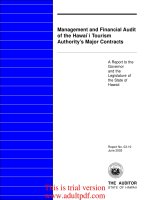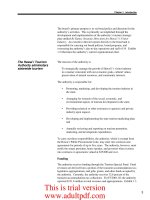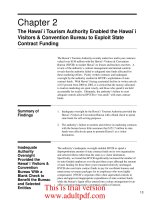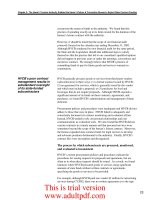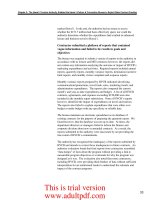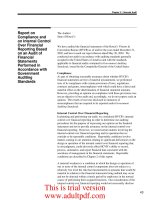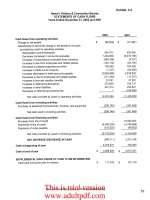Management and Financial Audit of the Hawaii Tourism Authority’s Major Contracts A Report _part3 pptx
Bạn đang xem bản rút gọn của tài liệu. Xem và tải ngay bản đầy đủ của tài liệu tại đây (53.55 KB, 10 trang )
13
Chapter 2: The Hawai`i Tourism Authority Enabled the Hawai`i Visitors & Convention Bureau to Exploit State Contract Funding
Chapter 2
The Hawai`i Tourism Authority Enabled the Hawai`i
Visitors & Convention Bureau to Exploit State
Contract Funding
The Hawai`i Tourism Authority recently ended two multi-year contracts
valued over $150 million with the Hawai`i Visitors & Convention
Bureau (HVCB) to market Hawai`i to leisure and business travelers. A
review of the authority’s contract management and internal controls
reveals that the authority failed to safeguard state funds allocated for
these marketing efforts. Poorly written contracts and inadequate
oversight by the authority resulted in HVCB’s exploitation of state
contract funds. With Hawai`i facing a potential decline in visitor arrivals
of 8.5 percent from 2000 to 2002, it is critical that the moneys allocated
to tourism marketing are spent wisely, and those who spend it are held
accountable for results. Ultimately, the authority’s failure to exert
adequate controls allowed HVCB to “run amok” with state contract
funds.
1. Inadequate oversight by the Hawai`i Tourism Authority provided the
Hawai`i Visitors & Convention Bureau with a blank check to spend
state funds for self-serving purposes.
2. The authority’s failure to monitor and enforce its marketing contracts
with the bureau leaves little assurance that $151.7 million in state
funds were effectively spent to promote Hawai`i as a visitor
destination.
The authority’s inadequate oversight enabled HVCB to spend a
disproportionate amount of state contract funds on its own organization
and selected others rather than the state as a visitor destination.
Specifically, we found that HVCB significantly increased the number of
its state-funded employees over the past three years although the amount
of state funding for those three years remained relatively unchanged.
HVCB also used state contract funds to pay for exorbitant bonuses and
unnecessary severance packages for its employees who were highly
compensated. HVCB’s corporate office often superseded controls in
place and approved inappropriate expenditures of state contract funds,
while the bureau’s Japan office entered into a salary arrangement for an
office executive that creates a potential conflict of interest.
Summary of
Findings
Inadequate
Authority
Oversight
Provided the
Hawai`i Visitors &
Convention
Bureau With a
Blank Check to
Benefit the Bureau
and Selected
Entities
This is trial version
www.adultpdf.com
14
Chapter 2: The Hawai`i Tourism Authority Enabled the Hawai`i Visitors & Convention Bureau to Exploit State Contract Funding
Questionable accounting practices enabled HVCB to circumvent the
return of unspent funds to the authority leading to a qualified opinion by
our consultant CPA firm. In addition, HVCB’s inadequate contract
management led to a lack of assurance that its subcontractors
appropriately used state contract funds. Finally, we found evidence that
HVCB used state contract funds in connection with an unusual
arrangement involving the former governor’s office.
Despite relatively level state contract funding, HVCB increased its state-
funded personnel roster by 20 percent and its state-funded personnel
costs by 42 percent from CY2000 to CY2002. HVCB also used state
contract funds to pay out large bonuses and severance packages to select
employees.
The number of HVCB state-funded employees increased by 20
percent
In CY2000, HVCB had 82 state-funded employees. By CY2002, the
number of state-funded employees had increased to 99—a 20 percent
increase in personnel over three years. The total compensation of state-
funded employees increased more than 42 percent over those same three
years—from $3.7 million in CY2000 to $5.3 million in CY2002.
HVCB’s total state funding, however, remained relatively constant over
the 3-year state contract period ($45.7 million for CY2000, $47 million
for CY2001, and $43.0 million for CY2002).
The increase in state-funded HVCB employees over the last five years—
from CY1998 to CY2002—is even more alarming. In CY2002, HVCB
reported spending about $5.3 million in state-funded personnel—more
than double the $2.5 million spent in CY1998. Exhibit 2.1 reflects the
number of HVCB employees paid with state contract funds over the last
five years from CY1998 to CY2002.
HVCB employees received generous compensation, exorbitant
state-funded bonuses, and unnecessary severance packages
Prior to the authority’s establishment in 1998, the Department of
Business, Economic Development and Tourism (DBEDT) contracted
with HVCB to provide state tourism marketing. Under the department
contract, HVCB was prohibited from using state contract funds to pay
for portions of HVCB employees’ salaries in excess of amounts
approved by the department.
In 1998, the authority became the State’s lead tourism agency and
assumed responsibility for the HVCB contract. In comparison to the
HVCB’s state-funded
personnel
expenditures
dramatically increased
over the past three
years despite level
state contract funding
This is trial version
www.adultpdf.com
15
Chapter 2: The Hawai`i Tourism Authority Enabled the Hawai`i Visitors & Convention Bureau to Exploit State Contract Funding
Exhibit 2.1
HVCB Staff Paid with State Contract Funds
CY1998 to CY2002
0
20
40
60
80
100
120
CY1998 CY1999 CY2000 CY2001 CY2002
$-
$1,000,000
$2,000,000
$3,000,000
$4,000,000
$5,000,000
$6,000,000
No. of Employees Total Compensation
Source: Hawaii Visitors & Convention Bureau
This is trial version
www.adultpdf.com
16
Chapter 2: The Hawai`i Tourism Authority Enabled the Hawai`i Visitors & Convention Bureau to Exploit State Contract Funding
department, the authority gave HVCB far more autonomy in establishing
salaries and bonus and incentives programs. Unlike the department
contract, the authority contract provided little oversight and no
constraints on the amounts of HVCB employees’ salaries. As a result,
HVCB salaries and bonuses increased significantly after the authority
assumed responsibility from the department for the HVCB contract.
We found eight HVCB employees who were compensated between
$90,000 and $170,000 using state contract funds during CY2002. Three
of the highest paid bureau employees experienced more than a 29 percent
increase in their total compensation between CY2000 and CY2002.
We also found that HVCB awarded over $500,000 in state-funded
bonuses from CY2000 to CY2002. Individual state-funded bonuses over
the three-year period ranged from about $100 to $65,000 and were based
on performance goals. For example, conventions, meetings and
incentives contract employees received a $2,500 bonus if they reached
80 percent of their individual production goals in terms of generating
hotel leads, room nights, or bookings. If these employees reached 100
percent of their individual production goals, they earned a $5,000 bonus.
Employees were also eligible for additional incentive program bonuses
up to $6,000 if they exceeded their production goals. Several HVCB
employees received individual annual bonuses in excess of $25,000.
The authority did not assess the appropriateness of the salary levels or
the incentive program bonus amounts. The authority’s non-involvement
and apparent lack of accountability have been exploited by HVCB in
establishing compensation thresholds for state-funded bureau employees.
Such authority deficiencies have resulted in unfettered increases in the
number of HVCB state-funded employees, as well as in the amount of
their salaries and bonuses.
In addition, we found that HVCB utilized state contract funds to provide
several employees with severance pay. On January 1, 2003, marketing
of the Hawai`i Convention Center was transferred from HVCB to the
convention center’s operator—SMG. As a result, a number of HVCB
employees assigned to meetings, conventions and incentives marketing
were terminated. Although HVCB was not obligated to provide these
employees severance pay, HVCB paid and accrued approximately
$202,000 in severance pay using state contract funds. One employee’s
severance pay was approximately $141,000, nearly the equivalent of that
employee’s annual salary.
Moreover, one employee who received severance pay was subsequently
hired by SMG, the convention center operator that took over after
HVCB. In effect, this employee was paid twice with state contract funds
at the same time—first upon severance from HVCB and then upon hiring
by SMG.
This is trial version
www.adultpdf.com
17
Chapter 2: The Hawai`i Tourism Authority Enabled the Hawai`i Visitors & Convention Bureau to Exploit State Contract Funding
When asked about the severance payments, HVCB responded that
payments were intended to ensure a smooth transition from HVCB to
SMG. HVCB represented that the severance packages were established
with the authority’s agreement. The authority disagreed, stating that
authority officials had neither requested the severance packages nor had
knowledge that the severance pay had been paid with contract funds.
We question whether providing almost a quarter of a million dollars in
severance pay was a prudent use of state contract funds. We further
question the appropriateness of a single employee being paid both
severance pay and salary at the same time by funds intended to market
the convention center. Finally, we raise grave concerns regarding the
payment by HVCB of over $202,000 in severance pay without the
authority’s knowledge.
Our review of a sample of HVCB state contract expenditures from
January 2002 through October 2002 found that HVCB inappropriately
spent $191,000 in state contract funds. In some cases, HVCB violated its
own policies for reimbursable expenditures. In other cases HVCB did
not exercise adequate controls over expenditures that resulted in the
misuse of state funds. We also found several instances where HVCB
used state contract funds to pay for other state agencies’ expenditures
under questionable circumstances. Although we reviewed only a sample
of HVCB’s contract expenditures, we are concerned that HVCB’s abuse
of state contract funds may be widespread.
Numerous expenditures approved at the corporate level
violated HVCB’s own travel and entertainment policies
In January 2002, HVCB issued a travel and entertainment policy to:
provide guidance to travelers, travel arrangers, approvers, and auditors
on cost-effective management of travel, entertainment, and other
business expenses; identify reimbursable versus non-reimbursable
expenses; and clarify employee responsibility for controlling and
reporting travel, entertainment, and other business outlays. In
acknowledgement that travel and entertainment costs are two of the
largest controllable items in a company’s operating budget, HVCB
prohibits certain travel and entertainment expenses. For example, airline
upgrades, travel for companions or family members, traffic and parking
violations, and in-room movies or mini-bar refreshments are non-
allowable expenses.
The policy also prohibits using state funds to pay for department parties,
holiday parties, employee birthday gifts, or other occasions unless
approved by the HVCB president. We agree that using state marketing
funds to pay for such expenses is inappropriate.
HVCB’s Honolulu
corporate office
approved a plethora of
inappropriate state-
funded expenditures
This is trial version
www.adultpdf.com
18
Chapter 2: The Hawai`i Tourism Authority Enabled the Hawai`i Visitors & Convention Bureau to Exploit State Contract Funding
However, notwithstanding existing policies, we found numerous
instances where HVCB’s corporate office approved expenditures using
state contract funds that violated its own travel and entertainment policy.
For example, HVCB used about $2,000 in state contract funds to
purchase two first-class airline tickets even though the airline offered to
provide HVCB with coach class tickets free of charge. This violated
HVCB’s policy to use in-kind contributions whenever available. Exhibit
2.2 provides additional examples of HVCB’s practice of violating its
own travel and entertainment policy.
Some HVCB employees claimed and received excess
reimbursement for travel expenses
In addition to HVCB violating its own travel and entertainment policy,
we also found instances where employees claimed, and received
approval for, excessive reimbursement. Specifically, we found HVCB
employees who inflated their mileage and parking expense requests.
Even though the amounts involved each time may be small, there appears
to be an operant culture of taking advantage of the funding source—
public moneys.
For example, we reviewed an expense report submitted by a Chicago-
based employee requesting mileage reimbursement for a 25-mile trip.
Our research, however, revealed that the actual mileage of the trip is only
6.6 miles. HVCB’s corporate office approved the mileage
reimbursement. The same employee claimed 21 miles for a roundtrip
from the Chicago office to a restaurant. We found, however, that the
restaurant is less than 2.5 miles away from the office or approximately
five miles roundtrip. This reimbursement was also approved by HVCB’s
corporate office. Exhibit 2.3 identifies additional examples of excessive
reimbursement approved by HVCB’s corporate office.
While these overages do not represent a significant amount of money, it
is indicative of the HVCB’s lack of internal controls and lack of prudent
management of contract dollars. It also displays a tendency by HVCB to
pay the expenses of privately-funded employees with state contract
funds. Greater internal controls must be in place to ensure that state
funds do not support privately-funded employees and their expenses.
Expenditures by HVCB’s Kaua‘i Visitors Bureau and its
China and Japan offices indicate varying degrees of improper
management of state funds
The Kaua‘i Visitor’s Bureau has a staff of four state-funded positions
and an executive director who is paid through private funds. In CY2002,
the Kaua‘i Visitors Bureau had a budget of $2,479,248 comprised of
This is trial version
www.adultpdf.com
19
Chapter 2: The Hawai`i Tourism Authority Enabled the Hawai`i Visitors & Convention Bureau to Exploit State Contract Funding
Exhibit 2.2
Examples of Inappropriate Contract-Funded Expenditures
HVCB Policy Examples of Policy Violations
Traffic and parking violations are not
reimbursable.
HTA contract funds were used to pay for the HVCB
president’s $137 in parking and speeding tickets.
Extravagant meals and alcohol while
entertaining staff are not reimbursable.
HVCB’s five-year planning meeting on Kauai included a
$2,400 employee dinner with $545 in alcoholic beverages.
Upgrades for domestic air travel at the
expense of HVCB are not permitted.
The eastern region director of sales upgraded flights on
several trips for a total cost exceeding $1,000.
All family member travel expenses are
the sole responsibility of the employee.
HVCB’s president was reimbursed $174 for his family
members’ travel expenses.
State funds may not be used for
department parties, holiday parties, or
other occasions.
• State funds were used to pay for $93 in napkins and
refreshments for two HVCB office blessings.
• Gifts valued in excess of $800 were purchased for
HVCB’s outgoing board chair. These gifts included a
two-night stay at a Four Seasons Hotel, a massage, and
a golf package.
Hotel in-room movies are not
reimbursable.
HVCB’s president was reimbursed $359 for in-room hotel
movies he rented.
Gifts to business associates or clients
cannot exceed $25 per person per year.
• HVCB paid for a $600 family vacation for an American
Psychiatric Association representative who was
instrumental in booking the association’s convention at
the Hawai`i Convention Center.
• An HVCB subcontractor employee received a $110
floral arrangement purchased with contract funds.
Personal convenience is not acceptable
justification for car rental.
A Big Island Visitor Bureau employee was reimbursed $340
for a seven-day car rental because the employee shipped a
personal car to Maui in anticipation of an imminent
relocation to that island.
Source: Office of the Auditor
This is trial version
www.adultpdf.com
20
Chapter 2: The Hawai`i Tourism Authority Enabled the Hawai`i Visitors & Convention Bureau to Exploit State Contract Funding
state contract funding and private membership dues. We reviewed
expenditures paid and invoices received in CY2002. While we did find
instances of inappropriate or questionable expenditures of state contract
funds, such as purchasing an office Christmas tree and spending over
$100 for less than a pound of coffee for office use, they do not appear to
be widespread. Thus, based on our limited review of expenditures, the
Kaua‘i Visitors Bureau appears to monitor expenditures fairly well and
generally complies with policies and procedures.
Exhibit 2.3
Examples of Excessive Reimbursement for
HVCB Employees
Type Examples
Mileage
• An HVCB employee in the Chicago office requested
and received reimbursement for a 25-mile trip;
however, the actual distance traveled was only 6.6
miles.
• The same employee requested and received
reimbursement for a 21-mile trip; however, the actual
distance traveled was only 4.8 miles.
Parking
• An HVCB employee in the Chicago office was
reimbursed multiple times for parking in a structure
less than 0.5 miles away from the Chicago office. The
same employee is also reimbursed $230 a month for
regular employee parking in another parking structure
near the office.
• Another Chicago employee was reimbursed on 12
separate occasions for parking within blocks of the
Chicago office although the employee is reimbursed
$175 a month for regular employee parking in a
structure within walking distance of the office.
Airfare
• Almost $23,000 in first/business class travel by
HVCB’s president for several domestic and
international trips.
• Airfare of about $1,000 for a privately paid HVCB
employee to attend a training seminar.
Other
•
Bereavement and get-well flowers for the parents of
an HVCB executive who is paid with private funds.
• Employee parking for an HVCB staff that is privately
funded.
• Internet service for employees’ home computers.
Source: Office of the Auditor
This is trial version
www.adultpdf.com
21
Chapter 2: The Hawai`i Tourism Authority Enabled the Hawai`i Visitors & Convention Bureau to Exploit State Contract Funding
HVCB’s two China offices are located in Beijing and Shanghai. The
Beijing office, which is staffed by two state-funded employees, had a
CY2002 budget of $239,707. The Shanghai office, which is also staffed
by two state-funded employees, had a budget of $221,795 for the same
time period. Our limited review of the expenditure files for the China
offices did not uncover any examples of improper expenditures made
with state funds.
HVCB also has two offices in Japan—one in Tokyo and the other in
Osaka. For CY2002, the entire Japan market area was budgeted about
$10 million in state contract funds for leisure marketing. We reviewed a
sample of 113 expenditures made for the Japan market area representing
about 7 percent, or $730,000, of the total $10 million budget. Similar to
the China offices, we did not find any examples of improper
expenditures made with state funds in the sample we reviewed. We did,
however, uncover an unusual salary structure for a Japan office
executive that is supported by state contract funds.
Japanese consumers account for nearly one-fourth (24 percent) of all
arrivals to Hawai`i. However, unfavorable market conditions and
increased competition required HVCB to intensify its marketing efforts
to maintain and strengthen Hawai`i’s relationship with Japanese
consumers. Therefore, for CY2002, about 27 percent of HVCB’s total
leisure travel budget, or $10.1 million, was allocated to the Japan market
area. A vice president for Japan marketing oversees HVCB’s Japan
marketing division that is comprised of nine employees in Honolulu,
Tokyo, and Osaka. The Japan marketing division is entirely funded with
state contract funds.
Although the Japan market area receives a significant portion of the
leisure budget, HVCB also works with industry partners to develop
cooperative opportunities to ensure continued stability and growth of the
Japanese market. Specifically, the bureau has been actively
strengthening its relationship with air carriers by implementing
promotional programs. Carriers serving the Japanese market include
Japan Airlines (JAL), All Nippon Airways (ANA), Northwest, United,
and China Airlines.
Under an unusual arrangement, JAL pays a portion of the Japan vice
president’s salary and provides the vice president with JAL benefits. We
believe this arrangement creates the potential for a conflict of interest—
or at least the appearance of a conflict of interest.
The vice president, who was hired by HVCB in 1997, was a former JAL
employee. When the vice president was hired, HVCB was unable to
match his JAL salary. Therefore, HVCB agreed to allow JAL not only
The salary structure for
a Japan office
executive creates a
potential conflict of
interest
This is trial version
www.adultpdf.com
22
Chapter 2: The Hawai`i Tourism Authority Enabled the Hawai`i Visitors & Convention Bureau to Exploit State Contract Funding
to fund the balance of the salary that the employee would have received
had he remained with JAL but also to provide the vice president with
JAL benefits. Under the arrangement, HVCB submits monthly payments
to JAL representing HVCB’s portion of the vice president’s salary.
Although HVCB asserts that this arrangement does not give JAL an
unfair advantage in negotiating favorable cooperative marketing
partnerships, it would be reasonable for other air carriers serving the
Japanese market to disagree. Any arrangement that presents even the
appearance of a conflict of interest should be avoided so that marketing
activities supported by state contract funds are not tainted.
Under its three-year leisure contract with the authority, the bureau could
not expend more than $39 million annually. Although the leisure
contract did not contain any provisions for the disposition of unspent
contract moneys, any funds that HVCB did not commit or encumber
should have been returned to the authority at the end of each of the three
calendar years. Additionally, because HVCB is required to prepare its
financial statements in accordance with generally accepted accounting
principles, funds could be committed only if they were needed to pay for
goods to be received, or services to be rendered, by the end of each
calendar year. Funds should not be committed to pay for goods or
services to be provided in the subsequent year.
For the duration of HVCB’s leisure contract with the authority, HVCB
has been able to spend exactly up to its annual $39 million expenditure
limit. We find it highly suspicious that HVCB has never had unspent
state contract funds to return to the authority. Our suspicions prompted a
review of HVCB’s commitment of funds.
We found that HVCB committed funds to pay for future goods and
services—a direct violation of generally accepted accounting principles.
For example, in November 2001, HVCB accrued approximately $1
million to an advertising company although no related services were
provided by December 31, 2001. It appeared that the advertising
company pre-billed HVCB for services it had yet to provide. On another
occasion, the bureau accrued approximately $900,000 for various
advertising and production services in December 2002, even though the
services would be provided or completed in 2003. In Chapter 3 of this
report, our consultant CPA firm, Nishihama & Kishida, CPA’s, Inc.,
declares its qualified opinion on the HVCB financial statements for the
year ending December 31, 2002.
By adopting this practice that violates generally accepted accounting
principles, HVCB was able to spend exactly up to its limit and
HVCB violated
generally accepted
accounting principles
to circumvent contract
limitations
This is trial version
www.adultpdf.com
